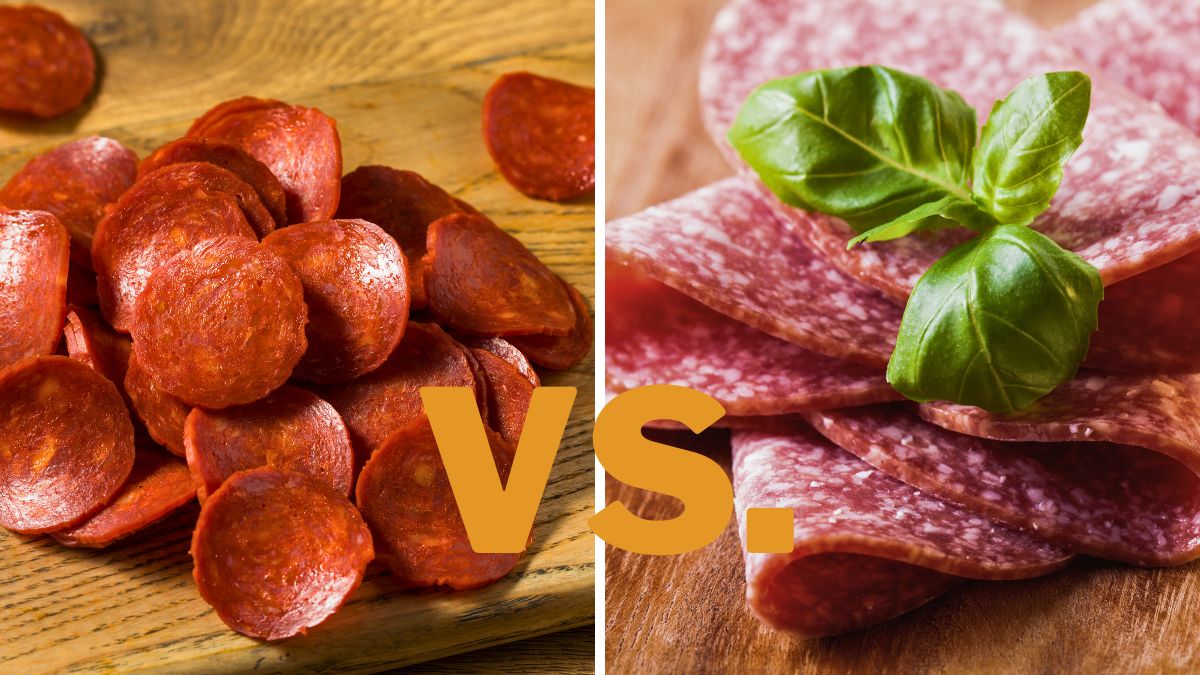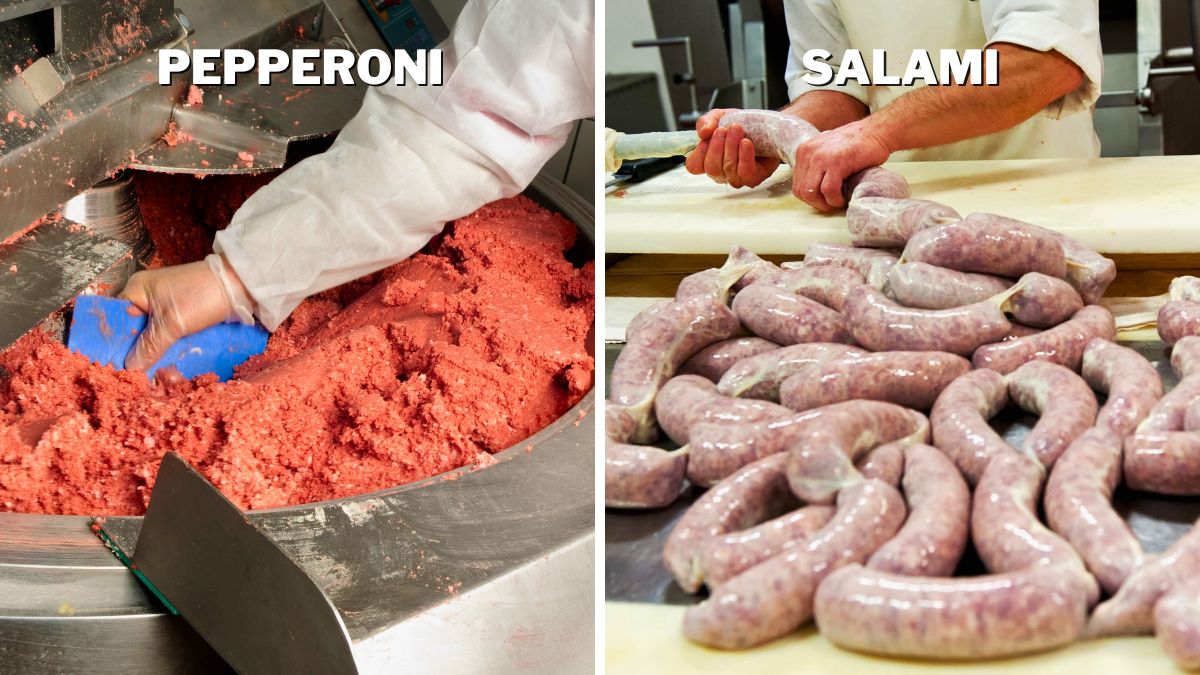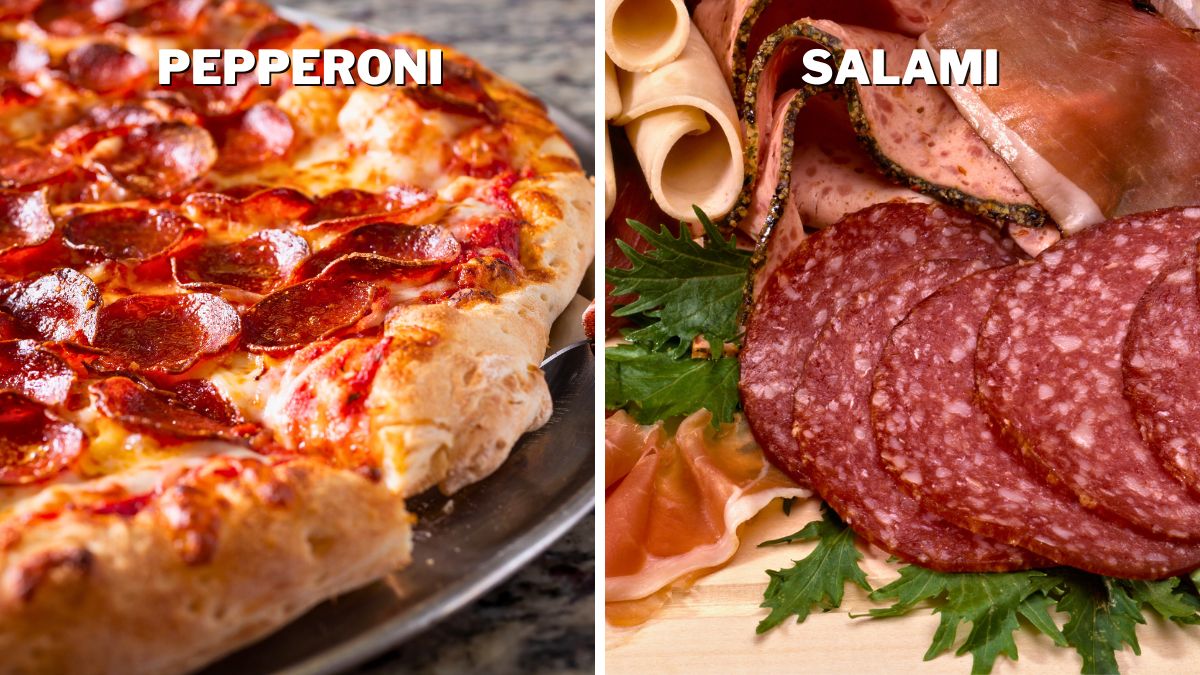Pepperoni vs. Salami: Differences & Which Is Better

I like to call pepperoni the younger sibling of salami since salami served as an inspiration for the birth of pepperoni. So, as long as the meat is delicious, who cares if it’s pepperoni or salami? Well, I do, and I couldn’t resist the temptation to compare these two in an article, so here it goes.
Mainly, pepperoni is made from beef and pork, seasoned with paprika, chili peppers, and garlic, with a spicy and smoky flavor, while salami is made from beef, pork, or both, and the spices depend on the maker.
But that’s not all! Since I appreciate both and really enjoy dissecting the differences between food items, I’ve done considerable research, both theoretical and practical. Let me tell you, eating salami and pepperoni in the name of science is lots of fun! Anyway, in this article, I will tell you all about the differences between these meats so you can choose wisely which to use where. There’s also a table summary at the end, so scroll down for the main takes!
What Is Pepperoni?
In addition to being an insanely delicious and popular deli meat, pepperoni is also the rebellious younger sibling of salami. It is a type of dry, cured sausage made from beef and pork, though variations can include other meats. It is seasoned with paprika, chili peppers, garlic, and other spices, resulting in a bold and spicy flavor.
What Is Salami?
Salami dates much further back than pepperoni and is, therefore, more complex. It is a category of dry, fermented sausages and can be made from various types of meat, such as beef, pork, and often a combination of both. The meat is mixed with salt, garlic, and a range of spices and is then left to ferment and dry.
Comparing Pepperoni and Salami
While they are quite different, pepperoni and salami have fooled many into thinking that they are the same product. Starting from the base ingredients to the seasoning to the making process, there are differences in each of these aspects. Take a look below and find out where and how these two delicacies differ.
Distinct Production Processes

Pepperoni and salami are made using very different preparation methods. While pepperoni is smoked and dried, salami is fermented and dried, which results in the core flavor and appearance differences.
Both are sausage types of meats, implying that the meat filling is stuffed into a sausage casing, so they have that in common.
Pepperoni is typically made using a faster preparation process and is often smoked and dried. This preparation method makes its production much faster, which is to be expected since it was produced on a larger scale to begin with.
Salami, on the other hand, is a different story. Since it was originally made by peasants for their own needs rather than for a large-scale business, the preparation method takes considerably longer compared to that of pepperoni.
It’s made through a slow fermentation and aging process, which can last for a few weeks to several months, depending on the meat, the seasoning, the surrounding conditions, and the preference of the maker.
I would say that pepperoni is a pop rendition of the classical salami.
Ingredients and Spices
Here, too, they differ, which further affects the taste.
Pepperoni is made with beef or pork, or sometimes even chicken. Depending on the brand, it can also include a combination of these meats. The meat is minced and then seasoned with seasoned with paprika, chili peppers, and garlic, hence the pronounced spicy and sometimes hot flavor.
Given that the meat is minced, a slice of pepperoni is smooth and fine-textured but noticeably greasy, which is its signature style.
Salami is made with pork or beef or a combination of the two, and the traditional recipe doesn’t usually include chicken, though it wouldn’t exclude the possibility of finding such a version. The seasoning varies widely, and it is entirely up to the maker.
Salami production is often within the family domain, and each family has its signature seasoning blend. From what I discovered, the salami spice blend often includes garlic, black pepper, and wine.
The meat in salami is coarser than the meat in pepperoni, resulting in a more robust texture where you can often feel the individual meat pieces. Frankly, I enjoy this texture more than that of pepperoni — it doesn’t mean that pepperoni isn’t good; this is just my preference.
Spicy and Smoky Taste of Pepperoni and Bold Taste of Salami
When it comes to the taste, delicious is an adjective that describes them both, but if we’re getting into detail, there’s much more to say. The flavors of these deli meats are surprisingly similar, considering the key differences between the ingredients and preparation processes.
Pepperoni has a spicy and smoky flavor. It releases a surprise tangy note, creating a mouthwatering sensation. Its greasy texture makes it even more seductive, but sadly, you cannot eat a lot of it.
It’s also very satiating, so a few slices are more than enough.
While pepperoni is pepperoni, and it always tastes, more or less, the same, salami is much more variable. Again, because the seasoning blend varies from maker to maker, no two salami brands taste the same. I mean, they are all bold, tangy, and peppery, but their surrounding notes are very variable.
I’ve had salami that tasted predominantly garlicky, and some even tasted like wine and pepper combined. It is also a very satiating deli meat, though I think I can eat more salami than pepperoni.
Appearance: Reddish Pepperoni and Marbled Salami
Before getting into detail, I must say that both look very inviting and appetizing. They also have similar shapes, which is understandable since they are both sausage-shaped.
Pepperoni is usually sliced in thin round slices with a reddish shade. When cooked, the edges are often crisper than the rest of the piece and curl inward. The whole piece, unsliced, resembles a large, thick sausage.
Salami has a darker shade and is often marbled due to the fat content of the meat. While pepperoni has a smooth texture on the surface, salami usually has lumps that make it appear even more appetizing.
Nutrition Differences
Even though the nutritional qualities of both can vary depending on the specific brand, both of these delicacies are far from lean meats. They contain high amounts of fat as well as sodium and don’t offer much nutrition in terms of minerals or other nutrients.
Although neither is very rich in protein, salami is the richer protein source, while pepperoni has more sodium. They do contain some nutrients, such as riboflavin, vitamin B, and zinc, though. [1] [2]
Cured meats, including pepperoni and salami, aren’t recommended to have very often and in large amounts, not that you can eat too much of either. In general, you should have them in moderation and not too frequently. [3]
Before diving into the nutritional details, please review our Nutritional Disclaimer page for important context and clarifications.
Uses and Serving Suggestions

This is the section where I could go on and on and still have more to say. Salami and pepperoni have been invented so that they can go with everything but sweets and desserts. You can add both in sandwiches, have them as a snack, include them in charcuterie boards, and add them to various dishes, omelets, salads, sauces, dips, and whatever else you can think of.
Pepperoni is known for its use as a pizza topping, and there’s nothing that can replace it in this regard. Salami is also used on pizzas, but it releases more grease inside, making the pizza fatty in a more obvious way.
They both do miracles in pasta dishes as well as anywhere you think that they would fit, which is practically any dish you want them in.
Standardized Pepperoni and Varieties of Salami
When it comes to varieties, pepperoni is the more limited one since it has been standardized pretty well. The reason for this is that it was intended for wider consumption from the get-go, and its recipe was supposed to produce a deli meat that is unified and quick to make.
Since salami was more of a family thing and still is, it has more variations. Although the meat is pretty much the same, the seasoning isn’t. So, you may encounter as many different flavors as there are brands you’ve tried.
Popular Substitutes
To me, both are irreplaceable, but they do have some pretty good substitutes. The spicy Italian sausage or the bold chorizo are decent substitutes for pepperoni and deliver many of its aspects. None replicates everything, but they come relatively close and are definitely worth every chance if you can’t find or have pepperoni for some reason.
Due to the variable nature of salami, it has a wider selection of substitutes you can choose from. Generally, any other dry-cured sausage can do the trick and do it well. Still, none of its substitutes will deliver the flavor entirely, but it will do a good job.
The soppressata or Genoa salami are the best salami substitutes I’ve tried.
Which Is Better, Pepperoni or Salami?
If you prefer a classic pizza or plan on generally prefer spicy and smoky flavors, go with pepperoni. If you want something more tangy and smoky, opt for salami.
These two are impossible to compare in terms of which is better since they are both very delicious and satisfying. So, the bottom line is which one you prefer and what you need it for.
Before you choose one, consider the use and specificities and base your choice on that. What makes things a bit more difficult is that pepperoni and salami can be used in very similar ways, so sometimes it may seem like an impossible decision. Maybe the table below will help you in making the decision.
| Criteria | Pepperoni | Salami |
|---|---|---|
| Production Process | Faster production often smoked | Slow fermentation and aging |
| Ingredients and Spices | Paprika, chili peppers, garlic | Garlic, black pepper, wine |
| Taste | Spicy and smoky | Varied (mild to bold) |
| Appearance | Thin, round slices with a reddish hue | Coarser, marbled appearance |
| Nutrition | Higher fat and sodium, lower protein | Moderately high fat and sodium, higher protein |
| Uses and Serving | Common pizza toppings, sandwiches, pasta | Charcuterie boards, sandwiches, pasta, standalone snack |
| Varieties | Limited variations | Many varieties |
| Popular Substitutes | Spicy Italian sausage, chorizo | Soppressata, Genoa salami, etc. |
Which one do you usually go for, and in which circumstances? I’m excited to read your recipe ideas in the comments below!
